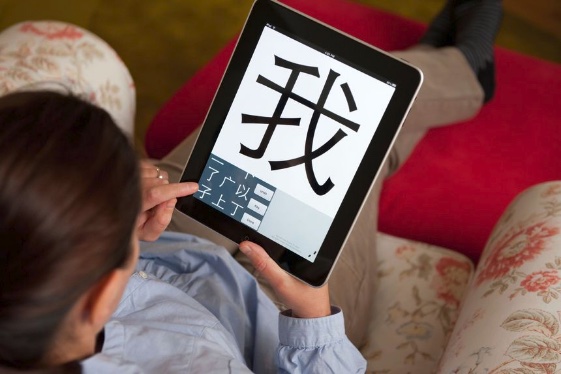A mishmash of languages, "dialects", and characters
« previous post | next post »
We've just been through the problems of standard language versus the vernaculars in Arabic (see "Selected readings" below). Now we're going to look at a photograph, a caption, a book review, and a letter to the editor that encompass these contentious issues in spades — but for Chinese. Here's the photograph:
Nothing wrong with the photograph. The students in Chennai, India did a respectable job of lining up to form these three characters: Xí Jìnpíng 习近平. The problems start with the caption provided for the photograph by the editors of the Wall Street Journal letters to the editor section where it appeared on 3/9/22:
Students sit in a formation that reads "Welcome" in Mandarin at a school in Chennai, India, October 10, 2019. (Photo: Reuters)
I dare say that nearly every Language Log reader will quickly catch the gross error in the caption. But the mistakes in the letter to the editor and in the original book review only compound that of the caption.
Here's the letter to the editor:
"China’s Long Road to Mandarin: It took Mao’s authoritarianism to impose linguistic conformity." WSJ (March 9, 2022)
Regarding Hugo Restall’s review of “Kingdom of Characters” (Bookshelf, March 2): The Beijing dialect, known in the West as Mandarin, was voted by the Kuomintang to be the guoyu, or national dialect, in 1932. Since then, an effort has been made to unify the dialect for everyone. But there are hundreds of local dialects in China, and Mandarin couldn’t replace them no matter how hard the Nationalists tried. This changed only after Mao took over, with a uniquely authoritarian government. Today, the Beijing dialect is spoken by most Chinese.
The First Emperor of the Qin Dynasty unified the written language. It took a long time—around 2,200 years—for the spoken dialect to follow.
Kathleen Yang
All this talk of "the Beijing dialect", "the dialect", "national dialect", "local dialects", and "spoken dialect" is nauseating. Not one word about "language" except in relation to writing. You can see whence the problems and the prejudices arise. The blatant misconceptions in the letter to the editor — privileging of writing over speech and disdaining all topolects except a single politically powerful one (never mind that it differed radically through time and space depending upon who was on top at a given moment) — also exist in the review it is commenting on, and indeed in the book being reviewed:
"‘Kingdom of Characters’ Review: Strokes of Genius: Many believe Mandarin to be a language of the future, but it was once considered a stumbling block to Chinese modernization." By Hugo Restall, WSJ (March 1, 2022)
The caption accompanying the photograph illustrating the review is also seriously misleading:

Learning Mandarin on an iPad. (Photo: Alamy)
Ugggh!
See if you can spot at least one flagrant falsity in the caption.
Here's a short, simple, straightforward, easy, elegant corrective:
- David Moser, A Billion Voices: China's Search for a Common Language (Penguin, 2016)
And here's a lengthier, more challenging account of what happened with regard to the Sinitic languages and topolects during the 20th century:
- S. Robert Ramsey, The Languages of China (Princeton, 1987)
There is probably no subject on earth concerning which more misinformation is purveyed and more misunderstandings circulated than Chinese characters (漢字, Chinese hanzi, Japanese kanji, Korean hanja) or sinograms.
–Victor Mair
from the foreword to Ideogram, by J. Marshall Unger
Quoted on the homepage of http://www.pinyin.info/
Selected readings
- "Arabic and the vernaculars" (3/6/22)
- "Arabic and the vernaculars, part 2" (3/8/22)
- "Arabic and the vernaculars, part 3" (3/9/22)
- "Arabic and the vernaculars, part 4 — the case of Bible translations" (3/10/22)
- "Language is not script and script is not language" (1/23/22) — there are countless other LL posts that deal with the problems of spoken versus written language, languages versus dialects, and related issues.
[Thanks to Mark Metcalf]

David Moser said,
March 14, 2022 @ 12:26 am
“There is probably no subject on earth concerning which more misinformation is purveyed and more misunderstandings circulated than Chinese characters (漢字, Chinese hanzi, Japanese kanji, Korean hanja) or sinograms.” I had forgotten this spot-on quote by you. Seems just as true now in 2022 as it was when you wrote it in 2003. Alongside the confusions of the word "dialect", I would also nominate the word "Mandarin" as one of the most misused, mis-applied and misunderstood terms in the world language discourse.
Michael Watts said,
March 14, 2022 @ 6:15 pm
The first caption appears to have misidentified English as "Mandarin", which is kind of funny.
I can't for the life of me tell what's going on in the second picture, but it is a stock photo captioned by the photographer "Female student learning mandarin Chinese using education application on iPad tablet computer", and "Learning Mandarin on an iPad" would seem to be a faithful reflection of that. I don't see any way to rule it out as an interpretation of the photo.
(The higher-resolution preview available from Alamy reveals that the three buttons on the right of the lower blue area read "Undo", "Key", and "Done" (top to bottom). There is also text in the grey area to the blue area's right, but the preview isn't high-res enough to read it; someone would have to pay for the photo.
It escapes me what the relationship is between the giant 我 and the lower area(s). I'm also kind of confused by the presence of 以 and 孑 in the blue area – 以 is an outlier if the characters are being organized by stroke count, and 孑 is obscure, which would make it an odd choice for a "start learning Mandarin" app.)
Philip Taylor said,
March 15, 2022 @ 4:51 am
Michael — I believe that the "text in the grey area to the blue area's right" reads "tap with two fingers to clear ¶ tap again when clear to backspace". See https://chinese.bonyad.org/wp-content/uploads/2020/01/9-1-scaled.jpg
Michael Watts said,
March 15, 2022 @ 12:01 pm
That is the exact text displayed in Pleco's handwriting input pane. But despite that, the full screenshot still doesn't make sense to me. We have an oversized display of a single character, a small selection of other characters, and a handwriting input pane.
How'd you find the big image? I found Alamy by searching tineye, but your link doesn't show up in the results there.
Philip Taylor said,
March 15, 2022 @ 12:45 pm
Michael — opened Google's "Image search", selected "Search by image" (the camera icon), pasted in the image URL from this site, used the "Find other sizes of this image" option, chose "Large", then selected the first of the two images offered.